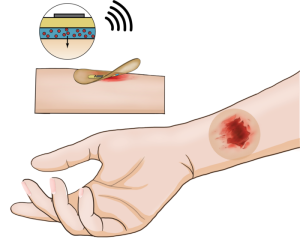Medtech
Chronic Wounds Heal Quicker with Smart Bandages
A wireless, smart bandage with integrated sensors and stimulators was shown to promote faster closure of wounds, increase new blood flow to injured tissue,…

Scientists at Stanford University say they have developed a wireless smart bandage that has shown promise in speeding up tissue repair by monitoring the wound healing process and treating the wound simultaneously. The study “Wireless, closed-loop, smart bandage with integrated sensors and stimulators for advanced wound care and accelerated healing” published November Nature Biotechnology, demonstrated that their device promotes faster closure of wounds, increases new blood flow to injured tissue, and enhances skin recovery by reducing scar formation.
“Smart bandages based on multimodal wearable devices could enable real-time physiological monitoring and active intervention to promote healing of chronic wounds. However, there has been limited development in incorporation of both sensors and stimulators for the current smart bandage technologies. Additionally, while adhesive electrodes are essential for robust signal transduction, detachment of existing adhesive dressings can lead to secondary damage to delicate wound tissues without switchable adhesion,” write the investigators.

“Here we overcome these issues by developing a flexible bioelectronic system consisting of wirelessly powered, closed-loop sensing and stimulation circuits with skin-interfacing hydrogel electrodes capable of on-demand adhesion and detachment. In mice, we demonstrate that our wound care system can continuously monitor skin impedance and temperature and deliver electrical stimulation in response to the wound environment.
“Across preclinical wound models, the treatment group healed ~25% more rapidly and with ~50% enhancement in dermal remodeling compared with control. Further, we observed activation of proregenerative genes in monocyte and macrophage cell populations, which may enhance tissue regeneration, neovascularization, and dermal recovery.”
Thickness of a single coat of latex paint
The electronic layer, including a microcontroller unit (MCU), radio antenna, memory, electrical stimulator, biosensors, and other components, is 100 microns thick—about the thickness of a single coat of latex paint.
All the circuitry rides on top of an engineered hydrogel that is integrated to both deliver healing electrical stimulation to the injured tissue and collect real-time biosensor data. The polymer in the hydrogel is designed to adhere securely to the wound surface when needed, yet to pull away cleanly and gently wound when warmed to a few degrees above body temperature (40°C/104°F).
“In sealing the wound, the smart bandage protects as it heals,” Yuanwen Jiang, PhD, co-first author of the study and a post-doctoral scholar in the lab Zhenan Bao, PhD, the K.K. Lee Professor in chemical engineering in the Stanford School of Engineering. “But it is not a passive tool. It is an active healing device that could transform the standard of care in the treatment of chronic wounds.”
Electrical stimulation, also known as galvanotaxis, has been previously reported to accelerate the migration of keratinocytes to the wound site, limit bacterial infections and prevent the development of biofilms on wound surfaces, to proactively promote tissue growth and help with tissue repair. The researchers were able to take this technology and integrate it with real-time biosensor data to provide a novel automated treatment modality that is informed by biosensors.
The took its study a step further, trying to understand why and how electrical stimulation heals the wound faster. They now believe that electrical stimulation promotes the activation of pro-regenerative genes such as Selenop, an anti-inflammatory gene that has been found to help with pathogen clearance and wound repair, and Apoe, which has been shown to increase muscle and soft tissue growth.
Likewise, electrical stimulation increased the amount of white blood cell populations, namely monocytes and macrophages, through the recruitment of greater amounts of M2 anti-inflammatory macrophages, which have been previously reported as pro-regenerative and playing a key role in the extracellular matrix formation that is required during the proliferative phases of wound healing.
The researchers caution that the smart bandage is, as yet, a proof-of-concept although, they add, a promising one.
The post Chronic Wounds Heal Quicker with Smart Bandages appeared first on GEN – Genetic Engineering and Biotechnology News.

ETF Talk: AI is ‘Big Generator’
Second nature comes alive Even if you close your eyes We exist through this strange device — Yes, “Big Generator” Artificial intelligence (AI) has…
Apple gets an appeals court win for its Apple Watch
Apple has at least a couple more weeks before it has to worry about another sales ban.
Federal court blocks ban on Apple Watches after Apple appeal
A federal appeals court has temporarily blocked a sweeping import ban on Apple’s latest smartwatches while the patent dispute winds its way through…














